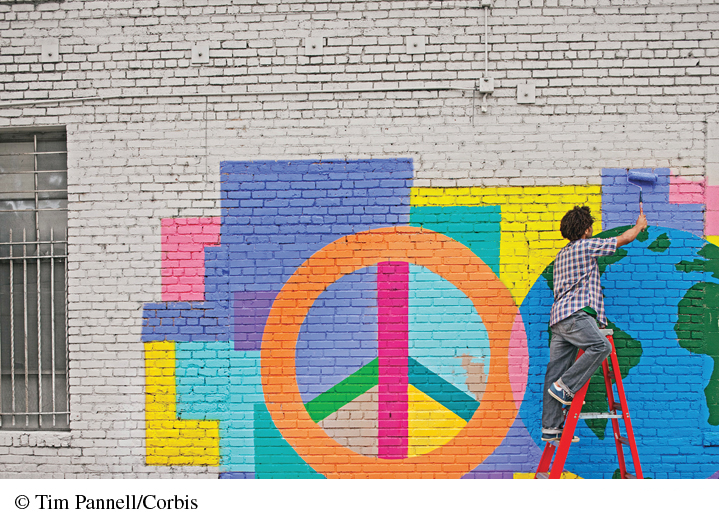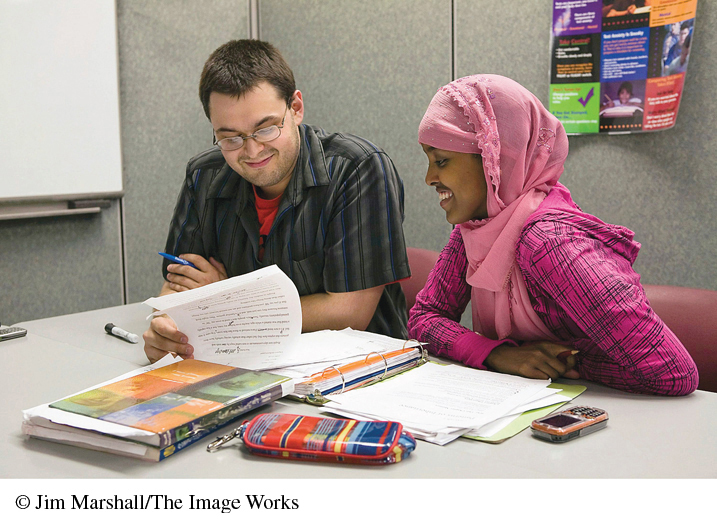Embrace Diversity
In school and at work, you’ll have many opportunities to build relationships with a diverse array of people, many of them different from you in any number of ways. Some of these differences might be visible, such as gender, skin color, age, and physical ability. Other differences may not be immediately apparent, such as income, religious affiliation, ethnicity, and sexual orientation.
The term diversity refers to characteristics or attributes that make us different from one another and that can be the basis for membership in a group. Differences make us unique, and they make the world a more vibrant and interesting place. Imagine how boring life would be if everyone was exactly the same!
Diversity: Characteristics or attributes that make us different from one another and that can be the basis for membership in a group.
In this section we explore many types of diversity you’ll encounter in life. We also consider the importance of respecting others’ experiences and appreciating what makes them who they are. Finally, we look at how thinking critically about your own actions and attitudes can help you build strong relationships with people of all kinds.
Recognize Differences
If you were asked to describe yourself, what would you say? Would you talk about physical characteristics, such as your hair color or height? Would you mention your age, where you grew up, or your life goals?
WRITING PROMPT: Using Table 11.2 as a guide, invite students to describe their own identity in writing. How do they think others view them? How does this differ from how they view themselves? Why is it important to know yourself?
When we describe ourselves, we can draw from many characteristics — physical appearance, personality traits, interests, family background, values, skills, and many more. All of us are multidimensional — we’re defined by many different aspects of our identity. As you think about the diversity you see on your campus, at work, and in your personal life, reflect on the characteristics that make us unique and shape our experiences. Just some of the many characteristics are listed in Table 11.2.
| Element | Description | Did you know? |
|---|---|---|
| Race | A way to classify people into groups according to physical characteristics such as skin color, hair color, facial features, and body build. | Guessing someone’s race based on physical features is risky because appearances may be deceiving. Further, many people are multiracial, which may not be clear from physical appearance alone. |
| Ethnicity | A way to identify a group of people with a common ancestral heritage and, often, a shared history and culture (language, traditions, food, clothing styles, values, beliefs, art, literature). | In the United States, people who identify as Hispanic or Latino (from places such as Mexico, Puerto Rico, and Cuba) are the largest and fastest-growing ethnic group.10 |
| Gender | Refers to characteristics that a society or culture defines as masculine or feminine. Gender is different than sex, which refers to biological rather than cultural differences.11 | Gender can also refer to one’s own experience of being a man or a woman (gender identity), how a person presents him- or herself to the world (gender expression), or expectations others have for an individual based on their perception of the person’s gender (gender roles).12 |
| Sexual orientation | Refers to an enduring pattern of attraction to others, such as persons of the opposite sex (heterosexuality), the same sex (homosexuality), or both sexes (bisexuality).13 | You may never know someone’s sexual orientation unless the person tells you. If someone shares his or her sexual orientation with you, don’t assume that it’s been shared with everyone else. |
| Mental and physical ability | Refers to a person’s ability to perform one or more major life activities, such as caring for oneself, walking, speaking, breathing, and thinking. | Mental or physical impairments, or disabilities, can limit someone’s ability to perform major life activities. Sometimes it’s clear that someone has a disability (such as when a person uses a wheelchair). Other times, the disability isn’t so visible (such as when a person has dyslexia). |
| Religion | An organized system of spiritual beliefs, traditions, and practices agreed upon by a group of individuals. | Many colleges offer classes on world religions. These classes can be a great way to learn more about different belief systems. |
| Socioeconomic status | Refers to social standing or prestige based on income, occupation, or education.14 | Visible status symbols, such as the way a person dresses, don’t always accurately reveal socioeconomic status. Some wealthy people spend modestly, for instance, while some people in financial straits spend lavishly to build their image. |
| Age | Indicates how old a person is, which determines the social, political, economic, and technological events the individual is exposed to in his or her lifetime. | Terms such as Baby Boomers (born 1946–1964), Generation X (born early 1960s to early 1980s), and Millennials (born early 1980s to early 2000s) are used to classify people who were born during different time periods. |
Respect Differences
ACTIVITY: Divide students into groups of three or four and have them think of a few ways they can celebrate diversity, either for this class or in general. Next, ask them to think of two or three ways they can increase tolerance in this class or in their personal lives.
When you meet students and instructors in your classes, colleagues at work, or people in your personal life, they bring with them diverse experiences, backgrounds, beliefs, and opinions. You can build relationships with and learn from them by practicing tolerance: acknowledging, valuing, and respecting what makes them different from you and from one another. When you’re tolerant, you may not always agree with someone, but you try to understand his or her perspective by showing empathy and “agreeing to disagree.” Being tolerant means treating people with dignity and respect, accepting that not everyone thinks or acts like you, and recognizing that diversity adds richness and color to life.
WRITING PROMPT: Ask students to write about a time when they or someone they know was mistreated as a result of intolerance. Have them respond to the following questions: What would have to happen for the person who acted in an intolerant way to change his or her view? How can you take steps to avoid this type of behavior in your own life? How can you embrace diversity?
Unfortunately, some people look down on or even mistreat those who are different from them. Such reactions can occur if a person has inaccurate beliefs about a particular group or has had a negative experience with a member of a group and then generalizes that experience to the larger group (“I don’t trust teenagers because a teenager vandalized my car last year”). Lack of exposure to a particular group can also cause such reactions because people can be suspicious of what’s unfamiliar. These reactions play a part in stereotyping, or assigning real, imagined, or exaggerated characteristics (negative or positive) to all members of a particular group — for example, “All American tourists are rude” or “Everyone from the East Coast is well educated.”
Treating people less favorably based on their membership in a particular group is called discrimination. For example, it’s considered discrimination if a manager avoids hiring well-qualified job candidates because of their age (ageism), race (racism), gender, religion, or sexual orientation. Colleges and workplaces have established policies against all forms of discrimination, so report any incidents of discrimination you witness. Doing so will help make these environments safe places for diverse ideas, interests, beliefs, opinions, and lifestyles. If you’ve ever experienced discrimination, you know firsthand how important it is to combat it.
Discrimination: Treating people less favorably because of their membership in a particular group.

Think Critically about Differences
Thinking critically about yourself and others is vital to building relationships with people who are different from you. It can help you appreciate their perspectives, empathize with them, and develop new viewpoints. Let diversity enrich your relationships by using these strategies.
Know yourself. Consider the components of your own identity. What makes you visibly different from other students? What differences would people learn about only by getting to know you? How have these differences influenced the person you are today?
Page 273Know your biases. Ask yourself whether you feel uncomfortable talking or working with any groups of people. If so, what might have caused this discomfort? How might your own background and life experiences have influenced these feelings?
Gain information. Learn more about people who are different from you, including how their group has been treated throughout history. For example, take a class such as Men and Masculinity or Comparative Religions. Attend public events offered by your school, such as a Martin Luther King Jr. celebration. Learn how to create a safe space for lesbian, gay, bisexual, transgender, queer, and questioning (LGBTQQ) individuals by attending a Safe Zone Training Program.
Seek personal contact. The more you interact with people who have different backgrounds, the more comfortable you’ll feel. Talk together about the same things you would discuss with other friends. Explore what you have in common. Discover how you differ, and identify what’s interesting or valuable about those differences.
Be open to feedback. As you interact more with people who are different from you, you may unintentionally offend them through word or action. If this happens, use active listening to understand their viewpoint, and remain open to their feedback. Apologize, and thank them for the opportunity to learn from the experience.
Advocate. Use your assertiveness skills to stand up for others whom you see being treated unfairly because of something that makes them different. Let people know that you don’t want to hear offensive language, jokes, stereotypical remarks, or insults directed toward a particular group of people, including any groups you’re a member of. Report illegal discrimination, hate crimes, and other abuse to authorities.
FOR DISCUSSION: As a class, come up with different ways students could use assertiveness skills to be an advocate for others. Start out by asking students how they can advocate within their own social circles, and then branch out from there.
